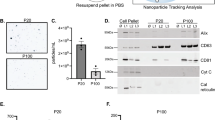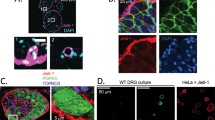Abstract
NERVE growth factor (NGF) induces neurite outgrowth and promotes survival of embryonic sensory and sympathetic neurons in culture1,2. In vivo, NGF decreases the extent of naturally occurring cell death in developing sympathetic ganglia and protects cholinergic neurons of the basal forebrain and caudatoputamen1-3. NGF interacts with the low-affinity p75 receptor and with Trk, a receptor tyrosine kinase encoded by the trk proto-oncogene4,5. To study the role of Trk in vivo, we have ablated the gene in embryonic stem cells by homologous recombination. Mice lacking Trk have severe sensory and sympathetic neuropathies and most die within one month of birth. They have extensive neuronal cell loss in trigeminal, sympathetic and dorsal root ganglia, as well as a decrease in the cholinergic basal forebrain projections to the hippocampus and cortex. These findings demonstrate that Trk is the primary mediator of the trophic actions of NGF in vivo and that this signalling pathway plays a crucial role in the development of both the peripheral and the central nervous systems.
This is a preview of subscription content, access via your institution
Access options
Subscribe to this journal
Receive 51 print issues and online access
$199.00 per year
only $3.90 per issue
Buy this article
- Purchase on Springer Link
- Instant access to full article PDF
Prices may be subject to local taxes which are calculated during checkout
Similar content being viewed by others
References
Levi-Montalcini, R. EMBO J. 6, 1145–1154 (1987).
Bradshaw, R. A., Blundell, R. L., Lapato, R., McDonald, N. Q. & Murray-Rust, J. Trends biochem. Sci. 18, 48–52 (1993).
Dreyfus, C. F. Trends pharmac. Sci. 10, 145–149 (1989).
Meakin, S. O. & Shooter, E. M. Trends Neurosci. 15, 323–331 (1992).
Barbacid, M. Oncogene 8, 2033–2042 (1993).
Klein, R. et al. Cell 75, 113–122 (1993).
Martin-Zanca, D., Barbacid, M. & Parada, L. Genes Dev. 4, 683–694 (1990).
Tessarollo, L. et al. Development 118, 463–475 (1993).
Mu, X., Silos-Santiago, I., Carroll, S. L. & Snider, W. D. J. Neurosci. 13, 4029–4041 (1993).
Holtzman, D. M. et al. Neuron 9, 465–478 (1992).
Steininger, T. L., Wainer, B. H., Klein, R., Barbacid, M. & Palfrey, H. C. Brain Res. 612, 330–335 (1993).
Butcher, L. L. & Woolf, N. J. in Handbook of Chemical Neuroanatomy Vol. II (eds Bjorkland, A., Hokfelt, T. & Kuhar, M. J.) (Elsevier, Amsterdam, 1984).
Davies, A. M., Lee, K.-F. & Jaenisch, R. Neuron 11, 565–574 (1993).
Johnson, E. M. Jr, Gorin, P. D., Brandeis, L. D. & Pearson, J. Science 210, 916–918 (1980).
Ruit, K. G., Elliott, J. L., Osborn, P. A., Yan, Q. & Snider, W. D. Neuron 8, 573–587 (1992).
Lee, K. F. et al. Cell 69, 737–749 (1992).
Klein, R. et al. Nature 368, 249–251 (1994).
Martin-Zanca, D., Oskam, R., Mira, G., Copeland, T. & Barbacid, M. Molec. cell. Biol. 9, 24–33 (1989).
McBurney, M. W. et al. Nucleic Acids Res. 20, 5755–5761 (1991).
Mansour, S. L., Thomas, K. R. & Capecchi, M. R. Nature 336, 348–352 (1988).
Author information
Authors and Affiliations
Rights and permissions
About this article
Cite this article
Smeyne, R., Klein, R., Schnapp, A. et al. Severe sensory and sympathetic neuropathies in mice carrying a disrupted Trk/NGF receptor gene. Nature 368, 246–249 (1994). https://doi.org/10.1038/368246a0
Received:
Accepted:
Issue Date:
DOI: https://doi.org/10.1038/368246a0
This article is cited by
-
Muscle spindle function in healthy and diseased muscle
Skeletal Muscle (2021)
-
The sympathetic nervous system in development and disease
Nature Reviews Neuroscience (2021)
-
Ntrk1 mutation co-segregating with bipolar disorder and inherited kidney disease in a multiplex family causes defects in neuronal growth and depression-like behavior in mice
Translational Psychiatry (2020)
-
Independent evolution of pain insensitivity in African mole-rats: origins and mechanisms
Journal of Comparative Physiology A (2020)
-
Early life stress disrupts intestinal homeostasis via NGF-TrkA signaling
Nature Communications (2019)
Comments
By submitting a comment you agree to abide by our Terms and Community Guidelines. If you find something abusive or that does not comply with our terms or guidelines please flag it as inappropriate.



